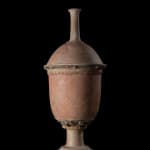Hellenistic
A Hellenistic pottery footed pyxis, Sicily, Centuripe, circa 3rd-2nd century BC
Pottery
Height: 77.5 cm
The vase of large scale and elegant form, painted pale pink throughout and decorated at the front around the bottom with ornate acanthus garlands and rosettes painted in blue and...
The vase of large scale and elegant form, painted pale pink throughout and decorated at the front around the bottom with ornate acanthus garlands and rosettes painted in blue and yellow, with ovolo beneath around the join with the separate foot. Around the top of the body there is an architectural frieze, the front part with additional ovolo and applied lion heads.
Provenance
With Galerie du Sycomore, ParisPrivate collection, Europe, acquired from the above in 1985
Literature
Centuripe ware, or the Centuripe Class is a rare type of of polychrome Sicilian vase painting from the 3rd - 2nd centuries BC. The type is named after its first findspot, Centuripe in Sicily. The vessels were typically large, and consisted usually of pyxides, lebetes, and lekanes in their shapes, all vase shapes traditionally used exclusively by women.Centuripe ware vessels are characterised by elaborate and delicate applied decoration and by refined polychromy executed after firing. The polychrome used tended to be pastel shades and some elements were gilded. The repertoire of figural subjects is limited almost entirely to women, erotes, and weddings. The few exceptions include scenes from the theatre and gods, mostly Dionysos. The prevalence of female-related subjects on such vases indicates that these vessels were designed for use in the female oeuvre. The painting can be sophisticated, with highlights modelling the forms and faces in three-quarters view. The class is important for adding to our knowledge about Hellenistic panel and wall painting, whose style the vases clearly drew upon.
For a similar example with preserved polychrome decoration in the collection of the Metropolitan Museum in New York see acc. no. 27.122.10a, b: G.M.A. Richter, 'Polychrome Vases from Centuripe in the Metropolitan Museum', Metropolitan Museum Studies, 2(2), 1929–1930, pp. 187–90, 203, figs. 1-3.



